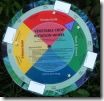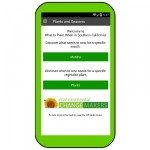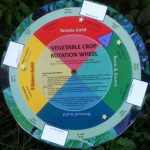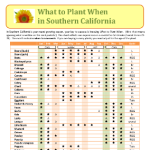Crop rotations in So. Calif: When to change seasons
 It’s autumn in Southern California. Or is it? The weather has changed. Wait, it’s changed back again…
It’s autumn in Southern California. Or is it? The weather has changed. Wait, it’s changed back again…
Contrary to what East Coast people say, Southern California does have its seasons. But there’s rarely a clear “cutoff” date. Add climate-change-driven Weather Weirdness to the mix and it can be totally confusing, even for veteran gardeners.
How do you tell when it’s time to change crops in your rotation?
The Wrong Way for So Calif
In East Coast gardening books, they refer to frost dates; here we don’t have a hard chill to delineate our seasons. Here we have a unique year-round growing season where we can harvest every single month of the year.
What’s more, the East Coast recommendations are completely wrong for Southern California. If you planted peas in spring like they tell you, your baby seedlings would fry before Memorial Day and never harvest. Here we plant peas sometime between Labor Day and mid-December to harvest abundantly all winter.
The Sidewalk Method
One friend gave me a simple rule of thumb: you know it’s cool season when you go outside barefoot and the sidewalk feels cold.
Try it. It works. Even during those 90 degree weeks we seem to get nearly every January, the sidewalk remains cold.
But when does this magical changeover happen? That part is hard to say.
The Calendar Method
Another simple method is to follow a planting calendar, such as our What to Plant When in Southern California. These calendars are based on historical observation by veteran gardeners.
So long as you choose one that was written relatively local to where you are gardening, they’re good for guiding new gardeners. They help you understand that – around here – broccoli is a winter crop and tomatoes are a summer crop.
As a gardener, you’re really setting yourself up for some hard work — wrestling pest control, shade cloth, warming green houses and cloches, etc. – if you try to grow plants outside their normal comfort zones.
The I’m Done Method
This may sound silly, but when your indeterminate tomatoes are done, around here that’s a good general indicator of the end of your warm season; time to plant your cool season crops. In spring, when the favas are done, it’s time to shift to warm season crops.
Old timers used to have sayings for the sequence of plants, such as planting certain vegetables “when the corn was knee high” or “in apple blossom time.” Much of this folk wisdom has now been lost, so we must rediscover the patterns and recreate the jingles.
The Art of Observation
At the Community Garden at Holy Nativity I follow parts of all of these. And after 20+ years of gardening food in Southern California, I follow none of these precisely.
The Sidewalk method is in my deep subconscious, and long ago I learned the basics of which crops were “cool season” versus which were “warm” for my area.
Unless I’m making a conscious commitment to high-needs babysitting that particular year, I rarely “push” plants outside their season. I feel no drive to have “the earliest” tomato, because my urban “fields” are usually still occupied with winter crops at the height of their harvest abundance.
In my early years as a food gardener, I followed planting calendars faithfully. (I also followed plant-by-the-moon calendars, but that is a topic for a different post.) These days, I notice the shifts of climate change. I have steadily been adjusting our What to Plant When in Southern California grid in attempts to stay on top of the changes. The VegGarden365 app contains the most current information.
If you want a low-effort garden, work deep within the band of time when weather conditions favor that vegetable.
At the Community Garden at Holy Nativity we always seem to have our hands full at season’s end. Suddenly, EVERYTHING seems to throw itself into abundant harvests, all at once. It’s rather like the grand finale at a fireworks show. It’s fairly evident.
And just as suddenly, the show is over. With fireworks, it’s clearly time to go home. In your vegetable garden, it’s time to clear and compost, then shift your dial on the Vegetable Crop Rotation Wheel to the next season, the new set of crops, and begin again.
Get your Vegetable Crop Rotation Wheel now


